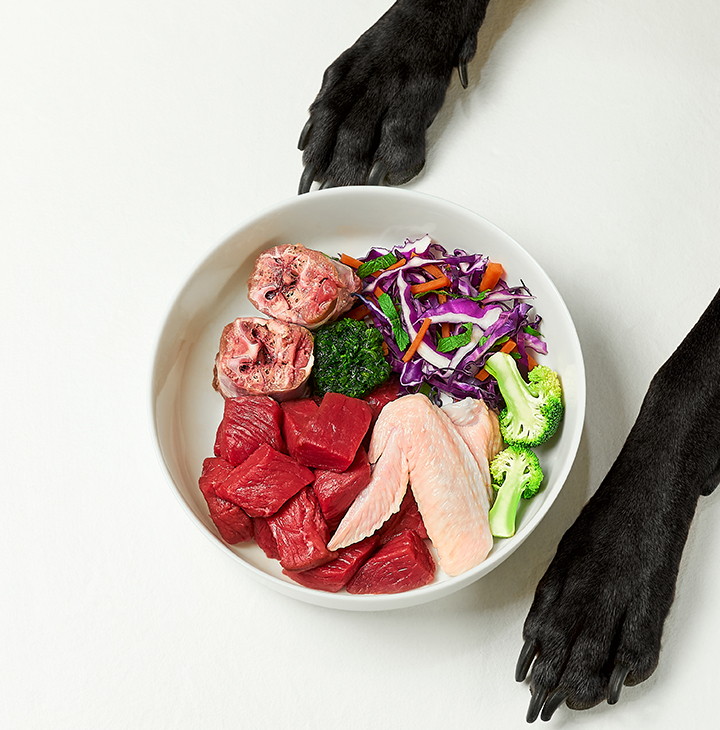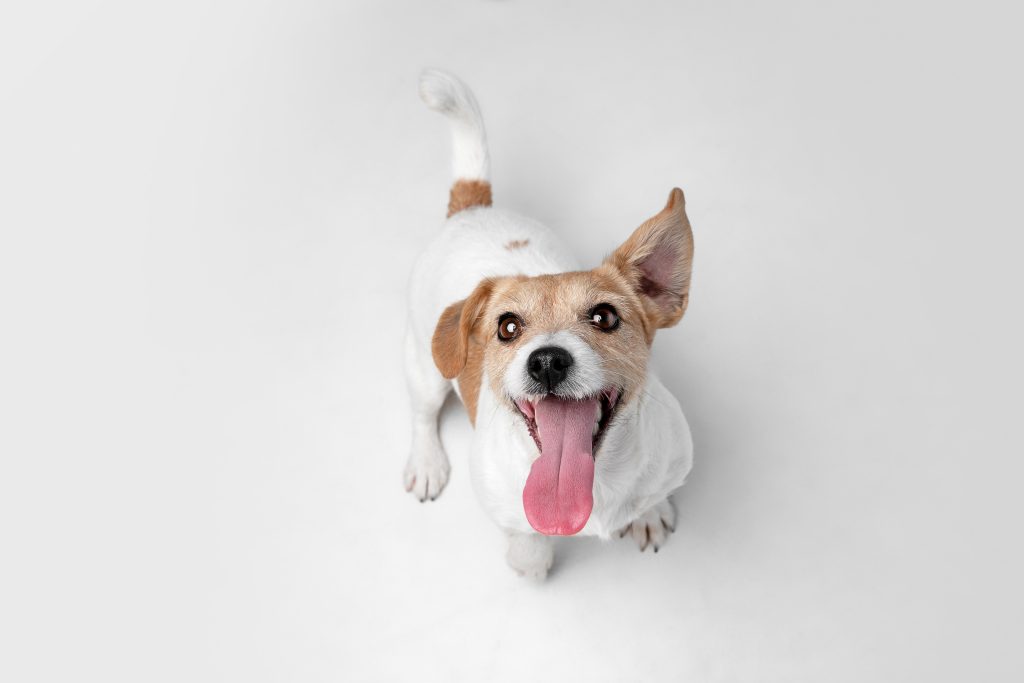How to transition your dog from eating kibble to eating a raw diet.

How to transition your dog from eating kibble to eating a raw diet.
Odds are you’ve probably heard by now that feeding your dog off-the-shelf kibble isn’t the healthiest option for them. But there’s tons of conflicting and overwhelming information out there about what kind of diet is healthiest for our four-legged friends. So, if kibble isn’t cutting it, what’s the solution?
By feeding your dog a truly raw diet—their ancestral diet—you allow them to be their most natural and healthy selves. It may not be what we’re used to, thanks to the commercialization and convenience of off-the-shelf and over-processed kibble, but a raw diet is what’s best for our dogs.

Why make the switch from kibble to a raw diet for your dog?
We all want healthy, happy, vibrant pets and the diet we choose to feed them plays a big part in how they’ll live their lives. Because a raw diet is more nutrient-dense than kibble, your dog will be getting more of the essential vitamins and minerals that they need to thrive. As a result, many pet owners report that their dogs have more energy, shinier coats, healthier teeth, and overall improved health when on a raw diet. Healthier dogs = happier dogs.
The best way to transition to feeding your dog a raw diet from kibble.
Transitioning to a raw diet can be done in one of two ways. The first option is a slow and gradual transition, while the second option is a “cold-turkey” switch.
A gradual transition from kibble to a raw diet.
Some dogs and puppies who are particularly sensitive to diet changes can benefit from a slower, gradual transition from kibble to a raw diet. You may have heard the statement that raw food and kibble should not be fed together – but this is a myth. Dogs are facultative (aka scavenging) carnivores, which means that they are uniquely designed to eat multiple types of foods together. Therefore, a slow and gradual transition to raw can be ideal for sensitive pets. This can be accomplished by replacing 1/4 of their usual kibble with the equivalent calories in raw food for at least one week. As long as stools remain firm throughout this time period, the amount of raw food can be increased to replace half of the diet on week two. Progressing to week 3, the raw food can be increased to 3/4 of their diet, and a full raw meal replacement into week 4 as long as stools still remain firm and solid. When transitioning in this way with a puppy, it is important to use a complete and balanced raw food.
The cold-turkey transition method – an immediate transition from kibble to a raw diet.
Most dogs and puppies do well with a “cold-turkey” transition straight into a truly raw diet. For puppies, it is important to switch them to a balanced raw diet right away, be it ready-to-serve pre-made meals or DIY raw. When transitioning an adult dog with the cold turkey method to a DIY raw diet, these pets can take a slower approach with a bland diet of lean white raw meats, meaty bones, and cooked starchy vegetables before moving to a more varied and balanced raw diet. And when using a balanced premade to cold-turkey transition an adult, it is recommended to choose more bland white protein blends in the beginning when possible, and introduce richer red meat blends later on.
What changes to expect from your dog as they transition to a raw diet.
Imagine you had been eating only processed bran cereal for every meal, every day of your whole life, and then one day you’re given a strip steak with a full plate of fruits and veggies with a side of multi-vitamins.

No matter how healthy this new meal may be, the change may still be a bit of a shock to your system that isn’t used to it. Similarly with dogs transitioning from a purely kibble diet to a raw diet, it can sometimes take time for their bodies to get acclimated. There are different kinds of bacteria living in your dog’s gut on a kibble diet than there would be on a raw diet. The microbiome will take time to adjust and there may be candida yeast die-off symptoms when going from a carbohydrate-heavy kibble diet to a low-carb raw diet. While this transition is happening, there may be a few (totally normal) side effects to keep an eye out for.
Digestive changes – unusual stools, gas.
As your dog’s body adjusts to the new diet, you may notice changes in their stools. Raw food is more easily digested than kibble and your dog’s body will absorb more nutrients from an all-natural, raw diet. This typically results in few stools that are smaller and firmer. However, it is possible that your dog may experience loose stools or diarrhea during the transition period from kibble to a fully raw diet. While loose stools can happen during a diet change, it is ideal to choose a transition method that reduces or avoids them, and to take steps to resolve loose stools if they occur. To resolve loose stools, additions such as probiotics, digestive enzymes, and slippery elm powder can help. Also make sure that you’re adjusting the raw diet to one that is bland, lower in fat, and higher in fiber if loose stools occur. You shouldn’t expect to see softer stools for longer than one to two days. Once your dog’s body has transitioned over to a raw diet, you can expect fewer, smaller stools as your dog’s body needs to expel less waste with a natural, raw diet.
Drinking less water.
When you switch to a raw diet, you may notice that your dog is drinking less water. The over-processed kibble that your dog had been eating is dehydrated, requiring them to drink more water to compensate. With a truly raw diet, your dog is getting more of their daily required intake of water through their meals, so they will need to visit their water bowls less frequently throughout the day. That said, make sure you continue to keep plenty of fresh water available to your pets.
An excited appetite.
Raw food is often significantly more appealing to our furry friends than kibble is, so you may notice that your dog is more enthusiastic about mealtimes and that they’re scarfing down their food faster than ever.

If you do notice that they seem hungrier or are more interested in their meals than usual, it’s important to ensure that they are not overeating. Stick to the appropriate portion size for your pup to maintain ideal body condition, even if they’re begging for more.
While these are some common responses to watch out for when transitioning from kibble to a raw diet, it’s important to remember that every dog is different and will have different responses to this change in their diet. If you see anything that concerns you, we are always here to answer any questions you may have.
You might need a little something extra to entice your dog when they first switch to a raw diet.
Sometimes when you’re feeding your dog a raw meal for the first time, they’re not into it right away. Processed pet foods often contain compounds called palatants. These are flavor- or smell-enhancing compounds which have been known to increase the pet’s desire to eat. Palatants are used to increase the palatability of processed pet foods. However, a raw diet does not have these additives and your pet may find a raw diet bland in comparison at first. It would be like comparing a tasty, salty potato chip to some veggies for a snack. There may be a period of time when you begin the transition where you need to entice your dog and slowly introduce them to the food to get them onboard with this new change in diet. This is pretty rare, but it can happen, so we want to make sure you’re prepared in case it does. Some things to try:
- Add in a sprinkle of nutritional yeast. Many dogs enjoy the cheesy flavor and nutritional yeast is a great boost of B vitamins. And don’t worry, this will not cause yeast infections.
- Very lightly cooking the grinds over the stove. Cooking produces the Maillard reaction, which is the process of browning or “caramelizing” food. Even lightly cooking will increase the food’s palatability through this reaction. However, cooking does cause changes to the nutritional value of the food, like affecting amino acids and destroy some B vitamins, so it is ideal to work towards feeding completely raw.
- Adding in some warm bone broth or warm water.
- Set mealtimes that are consistent every day. Free feeding with kibble can often create a dog who grazes because in the past they were able to eat whenever they felt like it. This can cause picky behavior and obesity. Only offering food at set mealtimes creates a natural cycle of eating, digesting, then becoming hungry again before the next meal which will help reduce pickiness.
- Watch the treats. Be careful not to provide an excess amount of treats when a dog is showing picky behavior at mealtimes.
- Do not cater to pickiness in healthy dogs. Constantly catering to picky behavior will only reinforce the pickiness and make it worse. Your dog will learn that refusing their meal will get them a tasty new food, cooked food, or a tasty meal topper.
We’re here to help as you transition your dog from kibble to raw.
With Carnos, you aren’t thrown into the deep end of feeding raw without a life jacket. We know that the transition from feeding your dog a kibble-only diet to feeding a truly raw diet can be intimidating, so we’re here to help every step of the way. Whether you are brand new to the world of feeding raw or a seasoned pro, it’s important to us that each and every one of our customers feels supported in their journey.
Check out our vast inventory of resources or reach out to us directly to schedule a consultation call if you’d like some one-on-one guidance.
Disclaimer: This blog is intended for educational purposes only. You are responsible for your pets’ health and safety. We encourage you to research topics further and consult with your Veterinarian or Pet Nutritionist before modifying your pets’ diet. If you’d like more one-on-one guidance, we offer consultation calls with our in-house raw feeding experts.